A decent resume is a difference between a dream job and a rejection letter for most job seekers. If you write a decent CV, you will receive responses from every company to which you apply.
However, if your resume isn’t up to par, you’ll be waiting weeks, if not months, for a response.
Before you begin writing your resume, there are a few things you should do. It’s not a one-size-fits-all document, so each resume you prepare should be personalized to the position you’re looking for.
Table of contents
With that in mind, here are some suggestions to assist you:
Tip 1 – Being prepared is essential when writing a professional resume. To begin, prepare a list of:
- Previous jobs’ major accomplishments
- Soft, hard, and technical abilities
- Employer information, including date of hire, location, job title, and duties
- A college diploma, certifications, or licenses are examples of qualifications.
- Because you’ll need all of this information while creating your CV, taking note of it now will save you a lot of time later and won’t interfere with your creative writing.
Tip 2: Set aside time to work entirely on your CV.
Tip 3 – Find a peaceful spot where you won’t be interrupted and where you can focus.
And Tip 4 – Write without stopping to polish your wording along the way. That will happen at some point.
Tip 5 – Once you’ve written everything down, take a break for a few hours and come back with fresh eyes to edit your work.
RESUME FORMAT
Writing a resume is a distinct style. Remembering which tenses to use or when (and why) to eliminate pronouns can be difficult. Take a look to see which fonts and formats are appropriate.
- Fonts for Resumes
It’s critical to pick a screen-friendly typeface that’s also ATS-compatible and widely available. Helvetica, Garamond, and Georgia are some traditional resume fonts to consider. Unless you’re a designer, don’t use script typefaces or bespoke fonts, and don’t use font sizes smaller than 10.
- Pronouns and Tense
While discussing previous occupations, use the past tense, and when describing current work, use the present tense. Personal pronouns (I) aren’t used in traditional resume writing, so you can get right to the action.
- Action Words for a Resume
Action verbs spice up your writing, making it easier for recruiters and hiring managers to read your CV. Replace generic verbs like “managed” or “lead” with more engaging adjectives like “mentored” or “accelerated” at the beginning of each bullet point on your resume.
Check Out: How To Write An Executive Assistant Resume
How Do I Choose the Best Resume Format?
Reverse chronological, functional, or skills-based, and a combination of the two are the three sorts of resume formats.
The option you choose is determined by the sort of job you’re applying for as well as your level of experience:
Read Also: Career Change Resume Examples + Tips
1) Reverse chronological format:

This is the most common resume format, and it’s best for people who have a lot of relevant work experience for the position they want.
(2) Functional/Skills-based Format:
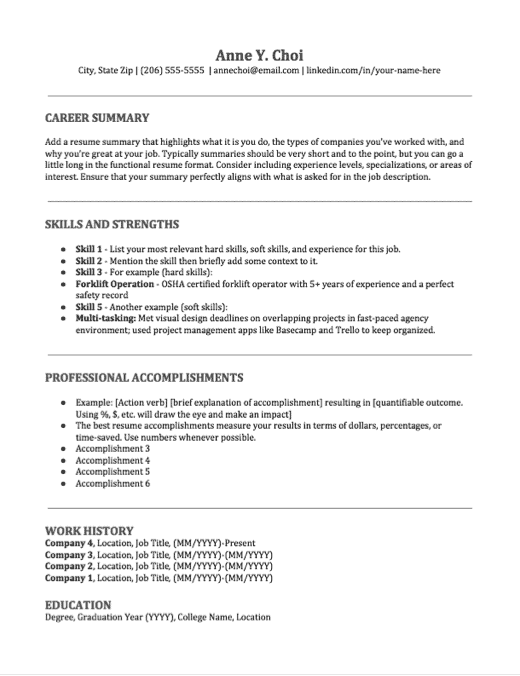
The skills-based structure is a preferable alternative if you lack relevant work experience as a student or recent graduate, or if you want to change careers.
3) Combination Format:

For jobseekers with a wide range of skills, a combo resume is an excellent option. It’s handy if you’re searching for a job that demands knowledge of three or four different fields and you want to demonstrate it all on your CV. Let’s say you’re seeking a senior management position that requires management, sales, and software development knowledge.
What to Include in Your Resume’s Content
Let’s get into the meat of how to write a resume now that we’ve covered the fundamentals. The following are the most common sections of a resume:
- Personal Information
- Summary or Objective for a Professional Resume
- Work Experience (and Achievements)
- Education
- Skills
Optional Sections
- Languages, awards, publications, Certifications, hobbies,
From top to bottom, every aspect of your resume will be reviewed, as well as what to write as well as how to write it so that you stick out and get the job you want.
1. Personal Information:
The most significant part of your CV is the “personal information” section. Even if you do everything right, you’re not likely to get very far if the HR manager can’t access you because you misspelled your email.
Make sure your contact information area is double-checked, if not triple-checked, to ensure everything is right and up-to-date. At the top of your CV, include the following information:
- Name
- Phone Number
- The location (City, State, Zip Code)
- Your email address
- URL to your LinkedIn profile
Here are two samples of how your contact information section can be formatted:
Sample 1

Sample 2

Tips for getting in touch with people:
- Always include a personal phone number rather than a professional phone number.
- Your full address isn’t required, but you should give your city, state, and zip code.
- Recruiters typically seek candidates in their proximity first.
- Make use of a professional-sounding email address. If you’re currently using an old email provider like Hotmail or AOL for your job search, consider getting a free Gmail account.
- Make a compelling LinkedIn profile and mention the URL on your resume.
2. Summary or Objective:
A resume summary is a two- to three-sentence description of your professional experience.
Unless you’re a recent university graduate or transferring careers, a resume summary should be used in almost every situation (in that case, you use a resume objective).
Use keywords and phrases from the job description to highlight your top skills and qualifications. Personal pronouns should be avoided (I, me, or my).
You must include the following in your resume summary:
- Your profession, as well as your years of experience.
- 1 or 2 outstanding accomplishments (or core responsibilities).
- The desired outcome.
Here are samples of how your summary should be formatted
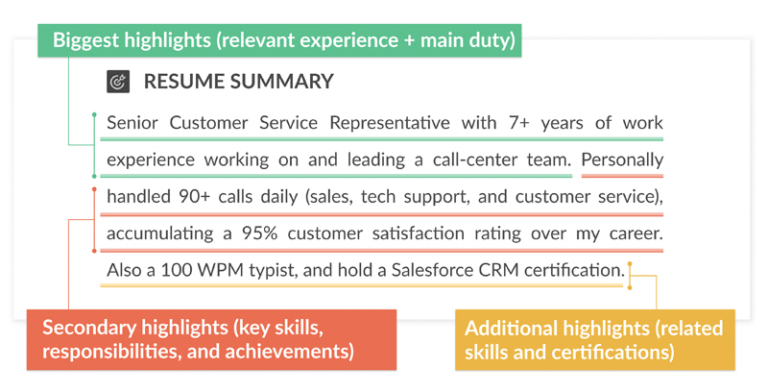

Tips for writing a resume summary:
- Examine your job history for patterns and offer a summary.
- Include only the talents that are most important and relevant to the position.
- Mention your most noteworthy accomplishments. The use of numbers and specifics earns you extra points.
- In your cv, include keywords from the job requirements.
Resume Objective
A resume objective (also known as a career objective) is a two- to a three-sentence statement that summarizes your talents and experience while also explaining why you’re interested in the employment.
If you’re an entry-level candidate, this approach is ideal because it centers on your career goals.
Example
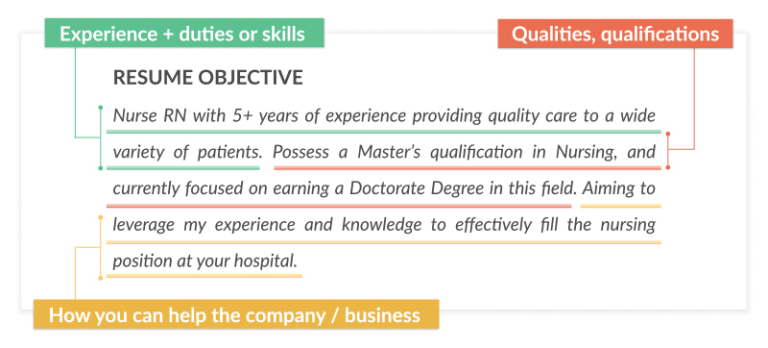
3. Work Experience:
Your work experience is the most significant element of your resume; this is where you sell yourself by demonstrating your previous accomplishments and responsibilities.
Employers scrutinize this section to see if your job history and past accomplishments identify you as a strong candidate. This area is your chance to show recruiters and hiring managers how you have provided distinctive value to other firms by detailing not just your work responsibilities but also your expertise in previous employment.
The job titles you’ve held and the level of firms you’ve worked with are the first things a recruiter looks for on your resume.
Stick to a familiar format to make the information easy to access, and if you perfect this section alone, you’ll know 80 percent or more of what there is to know about how to construct a resume.
There are several guiding principles to consider when writing your work experience. But, before we get started, let’s go over the essentials. In reverse-chronological order, list each job, and each job should have its subheading, this should include the following details:
- Organization
- Location of the job
- Your position title
- Start/ End dates
- Responsibilities and Achievements
As a general rule, each job title should include 3–5 bullet points outlining your major responsibilities and accomplishments in that area. A strong bullet point has three parts:
- The first is an action verb
- Second, there is a quantifiable point.
- 3rd: Specific and relevant work responsibilities
Here is a sample of how the work experience section should be formatted:
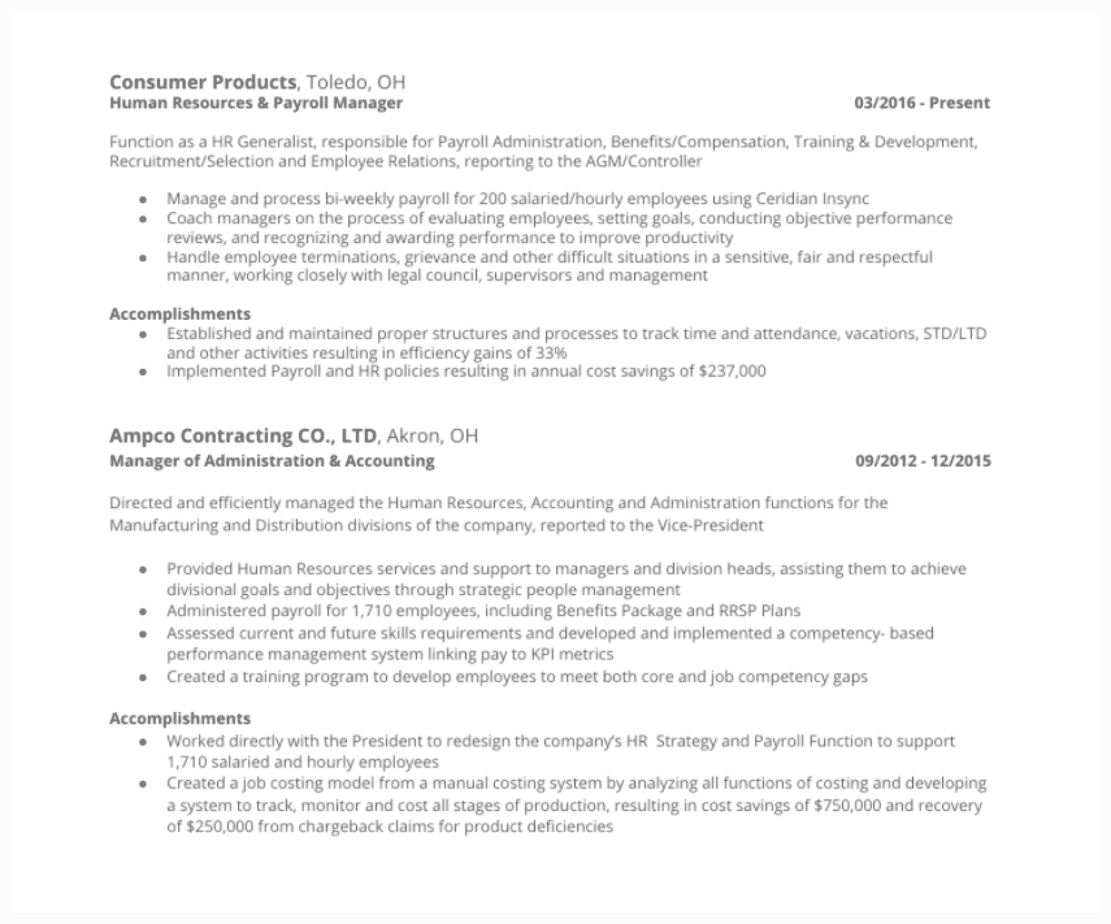
Tips for the work experience section:
- Use a conventional section title like “Work Experience,” “Professional Experience,” or “Job History” to organize your information.
- Wherever feasible, include explicit and measurable outcomes.
- Use as many appropriate skills and keywords as possible from the job description.
- Customize the material in this area to each position you apply for, highlighting or downplaying duties and talents as necessary.
4. Education:
A concise education section on your CV is vital, especially if you’re a recent college graduate with no professional experience.
If you don’t have any professional experience but have a strong academic record (excellent grades, club membership, honors, etc. ), your education section should be extended to highlight all of your educational achievements.
If you have more than a few years of work experience, on the other hand, you should make your education section brief. Let’s begin with the fundamentals: how to format the education section and what to include.
- Name of the program.
- Name of the university.
- Years of attendance.
- GPA (optional).
- Honors (optional).
- Academic achievements (optional).
- Minor (optional).
Here’s an illustration:

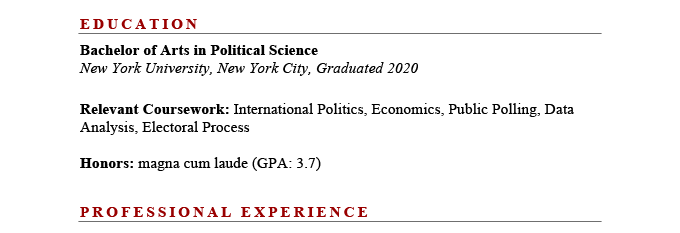
Tips for improving your education section include:
- If you don’t have any work experience, start with your schooling.
- On top of that, mention your most recent educational entry.
- If you have a university diploma, you should not include your high school.
- GPA should only be mentioned if you have had a stellar academic history (3.5 GPA plus).
5. Skills:
The “Skills” part of your resume is also a must-have. Here, you should list all of the qualifications that make you the best applicant for the job. Hiring managers are looking for candidates with specific job-related competencies.
While including a lot of abilities on your resume doesn’t necessarily mean you’re proficient, mixing them into different sections will capture the attention of whoever is reviewing your application.
In your introduction and work experience section, for example, you might highlight your hard and soft abilities.
Of course, under the skills area of your resume, you should mention your most valuable qualities (particularly any software or technological capabilities you have).
Two types of skills should be included in a good resume:
Hard Skills (Abilities that can be measured):
This can range from understanding how to code in Python to knowing how to prepare International cuisine. Some common hard skills include; Speaking in Public, understanding Languages other than English, Development of software, Presentation, Good use of Microsoft office tools, and Reporting on technical issues.
Personal talents (soft skills):
These include social skills, communication abilities, personal characteristics, career attributes, and so on. To mention a few, leadership, critical reasoning, administration, and information sharing.
Some basic soft skills include; Self-motivation, Discipline, Responsibility, Reasoning logically, Open-mindedness Tenacity, Empathy, and Cultural awareness.
Samples of skill section in a resume
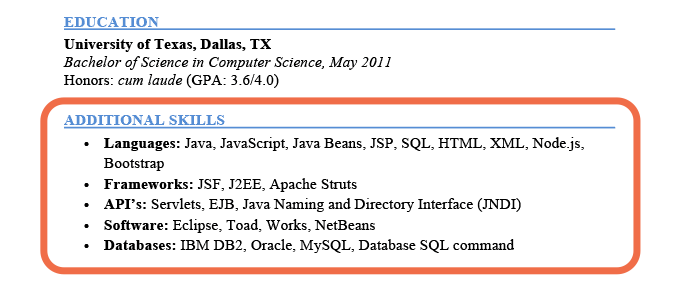
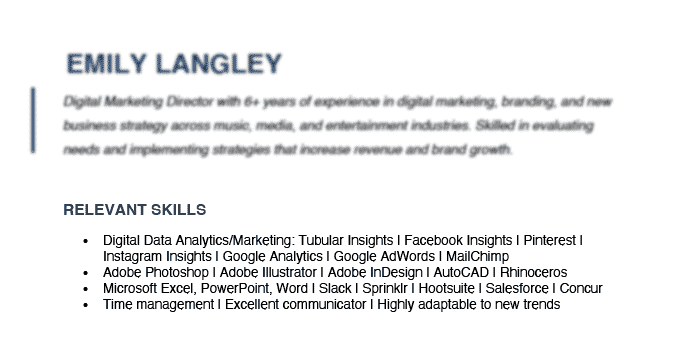
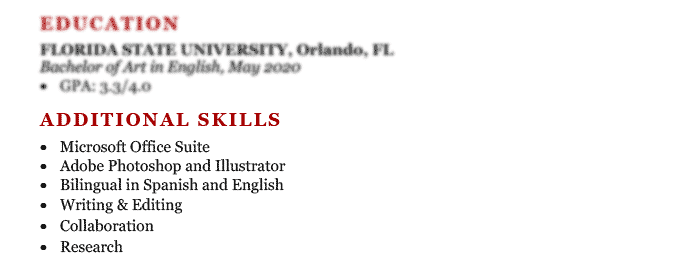
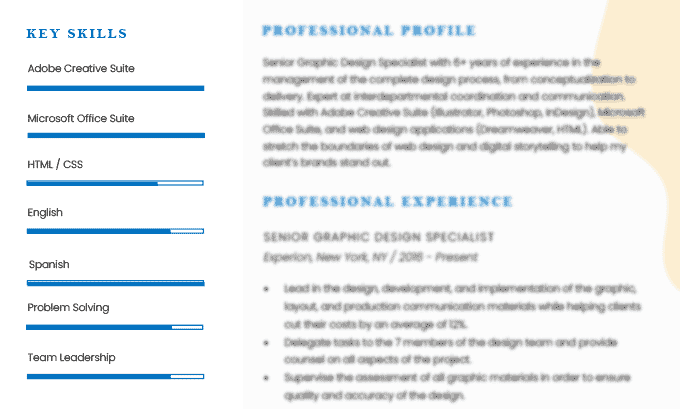
Optional Sections-
Language:
Even if the job does not need you to know a specific language, it may be useful in the future. At the end of the day, knowing more languages is always preferable to know fewer.
Simply write down the languages you want to include in your CV and allocate them to the proper level:
- Basic
- Intermediate
- Proficient
- Fluent
- Native
You never know, your recruiter might turn out to be a native speaker or even fluent in the language.
Hobbies/Interests:
If you have any extra space on your resume, a hobbies/ interests section is a great way to show off your personality.
Awards:
If you’ve got any medals or distinctions during your career or college, your resume is an excellent place to highlight them. On a CV, including accomplishments and relevant honors helps you stand out from the rest by demonstrating that you’re a dependable and diligent job seeker.
Sample;
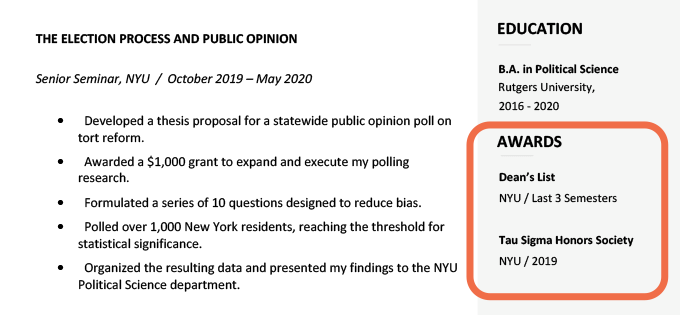
Publications:
If you have any works that have been published (online or in an academic publication), you should include them in your CV. Include a URL so that the HR department knows where to look at your work.
It’s also fine to include works that haven’t yet been published, “Works in Progress” or “Submitted for Publication” could be used to describe them.
Sample:

Certifications:
Certifications and licenses are required for some jobs but are not required for others.
Simply make sure you understand which licenses and certificates to include in your resume (if any) before sending it off, as leaving them out could make you appear unfit.
If you work in a field where qualifications are required, consider including a section on your resume titled “Certifications.”
Sample:
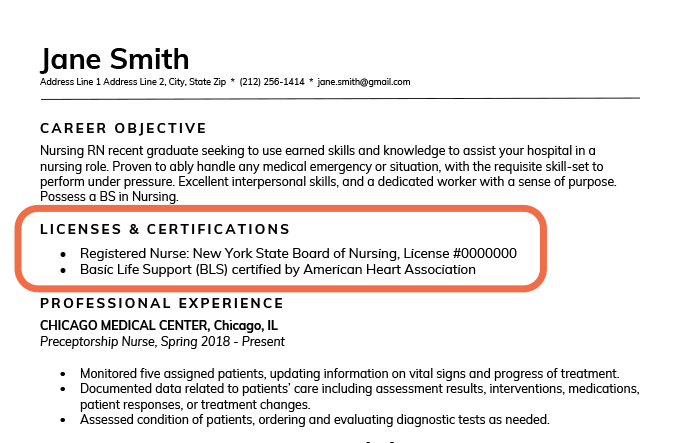
DOs and DON’Ts
DOs
- Do make a point of highlighting your most relevant experiences
The first guideline of resume writing is to create a unique version for each job you apply for, one that is personalized and tailored to the position. Make it clear to the hiring manager why you’re the best candidate for the job.
- Include soft skills in your resume
Soft skills can also benefit from the “quantifiable successes” strategy. Make sure that each bullet point identifies a trait that the hiring manager is looking for, and also use facts and data to show, not tell.
- Volunteering or other non-work experience should be considered
If volunteer work has taken up a considerable amount of your time or taught you skills relevant to the job you’re going for, consider including it on your resume, even if it’s unconventional. Side projects, pro bono work, and temp jobs are all good ways to beef up your resume and demonstrate other abilities.
DON’Ts
- If you lack relevant experience, don’t be concerned.
Whether you’re fresh out of college or switching careers, highlighting your transferrable abilities, related side projects, and relevant coursework can assist compensate for a lack of relevant work experience.
- Don’t Include Self-Explanatory Skills
Because everyone assumes you have a working knowledge of Microsoft Word. And then there’s the internet. Make the most of your limited CV space by emphasizing talents that set you apart.
- Using an Objective Statement Isn’t Necessary
The only time you’ll need an objective statement is if you’re making a significant professional shift. If you’re switching from business development to marketing, for example, your resume should clearly state that you’re transitioning jobs and possess the appropriate transferrable abilities. An objective statement, on the other hand, will squander important space if you’re a PR representative applying to a PR business.
FAQs
When;
There is an excessive amount of data.
A thicket of text.
There are grammatical and spelling faults.
Inaccuracies in your credentials or experience.
Personal information that isn’t required.
Your age.
A curriculum vitae should not exceed one page in length. There are, however, some instances where a two-page resume is acceptable. The length of the resume is irrelevant as long as all of the content is valuable and relevant to the employer.
If all of your positions are relevant and you’re not going past the 10-year restriction, you should mention as many as you can on your resume. The number of positions fluctuates between 7 and 3 in most cases. You shouldn’t bother about the exact amount as long as each job or position is relevant.
Errors and typos.
Email address that is unprofessional.
Gaps in employment.
Job descriptions that are vague.
Lack of advancement in one’s profession.
Conclusion
It doesn’t have to be difficult to write and update your resume. Consider it a dynamic document.
Take the time now, at the start of your career, to get your CV as professional as possible.
Then, whenever you start a new job, learn a new skill in your sector, or become certified in anything new, keep it up to date.
Maintaining your resume helps guarantee that you are constantly prepared when new chances arise.





